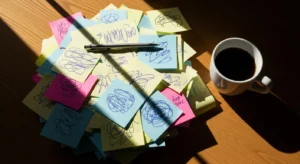
You have a task in front of you. It is important. You know you need to do it. And yet, you find yourself organizing your bookshelf, scrolling through social media, or suddenly deciding now is the perfect time to research the history of the stapler. This is procrastination. It is that frustrating, internal friction that keeps you from doing what you set out to do.
If this sounds familiar, you are not alone. And more importantly, you are not lazy or broken. Procrastination is not a character flaw. It is a complex emotional and biological response to a task. It is your brain trying to protect you from something it perceives as threatening, boring, or difficult.
Welcome. My name is Coach [Your Name], and here at TheFocusedMethod.com, we help people like you trade overwhelm for clarity. We believe that focus is a skill, not a gift. It can be trained, nurtured, and directed with the right tools and understanding. For years, I have coached professionals, students, and creatives to understand the root causes of their distraction and build sustainable systems for deep work.
In this article, we are going to pull back the curtain on the science of procrastination. We will explore why your brain defaults to avoidance and how you can work with your natural rhythms, not against them. This is not about willpower or just trying harder. This is about strategy. It is about understanding the mechanics of your own attention.
Forget the guilt and the self-criticism. We are going to replace them with practical, evidence-aware focus rituals. By the end, you will have a simple, 3-step plan to begin overcoming procrastination today. You will learn how to reduce the mental friction that holds you back and build momentum, one focused session at a time. Let us begin.
📚 Table of Contents
- Understanding the Brain on Procrastination: Why We Avoid
- A Practical System: 3 Steps to Build Focus Rituals
- Step 2: Mastering Break Hygiene and the Shutdown
- Step 3: Upgrading Your Mental Toolkit
- Worked Examples: Putting the Plan into Action
- Frequently Asked Questions About Procrastination and Focus
- Is it okay to listen to music or white noise while I work?
- I’ve heard multitasking is a myth. Is it really that bad?
- How do I handle dips in motivation? Some days I just don’t feel like it.
- I’m most productive in the evenings, but I feel guilty about it. Should I force myself to be a morning person?
- Conclusion: Your 7-Day Focus Action Plan

Understanding the Brain on Procrastination: Why We Avoid
To effectively address procrastination, we must first understand what is happening inside our minds. It is a battle between two parts of your brain: the limbic system and the prefrontal cortex. Think of the limbic system as your brain’s ancient, emotional, and impulsive core. It is responsible for your fight-or-flight response and seeks immediate gratification. When you face a task that feels unpleasant, overwhelming, or scary, your limbic system sounds an alarm. It says, “Danger! This is uncomfortable. Let’s do something else that feels good right now.”
This is where the amygdala, a key part of the limbic system, comes into play. It tags experiences with emotions. If a task is associated with past failure, stress, or boredom, the amygdala flags it as a threat. The resulting discomfort is what we often feel as the urge to procrastinate. Your brain wants to escape that negative feeling, so it pushes you toward a distraction—like checking your email—that offers a small, immediate hit of dopamine and relief.
Fighting against this is your prefrontal cortex. This is the more modern, rational part of your brain, located right behind your forehead. It is your inner planner, responsible for long-term goals, decision-making, and impulse control. It understands that finishing the report will be beneficial in the long run. However, the prefrontal cortex uses more energy and is weaker than the ancient, automatic limbic system. When you are tired, stressed, or hungry, your prefrontal cortex has a much harder time winning the battle. Procrastination is, in essence, the limbic system winning the argument.
The science of procrastination, according to research shared by institutions like the American Psychological Association, points to this emotional regulation failure. It is not about time management; it is about mood management. We procrastinate to avoid negative feelings associated with a task.

Cognitive Load and Energy Rhythms
Two other concepts are crucial for understanding this pattern: cognitive load and energy rhythms. Cognitive load refers to the total amount of mental effort being used in your working memory. Think of it as your brain’s RAM. When you have too many tabs open in your mind—unfinished tasks, worries, decisions to be made—your cognitive load is high. A brain struggling with high cognitive load is far more likely to seek escape through procrastination because it lacks the capacity to engage with another demanding task.
Furthermore, our energy is not constant. We operate in natural cycles known as ultradian rhythms. These are 90-to-120-minute cycles of high-frequency brain activity followed by a 15-to-20-minute period of low-frequency activity. Pushing yourself to work for hours on end without a break goes against this natural rhythm. When you hit the trough of your energy cycle, your prefrontal cortex is at its weakest, and the siren song of procrastination becomes almost irresistible. Recognizing and honoring these rhythms is a cornerstone of overcoming procrastination sustainably.
By understanding these forces—the emotional impulse to avoid, the limits of our cognitive load, and the natural flow of our energy—we can stop blaming ourselves. We can see procrastination for what it is: a predictable biological response. And anything predictable can be managed with the right system.

A Practical System: 3 Steps to Build Focus Rituals
Knowing the science is empowering. But knowledge alone does not complete the task. The next step is to translate this understanding into action. We will build a simple, three-part system of rituals designed to lower the barriers to starting, sustain your focus, and protect your energy. This is not about a total life overhaul. It is about creating small, repeatable routines that signal to your brain that it is time to engage.

Step 1: The Startup and Deep-Work Entry Ritual
The single biggest hurdle in overcoming procrastination is starting. A startup ritual is a short sequence of actions you perform every single time before you begin a focused work session. Its purpose is to reduce friction and automate the process of getting started, bypassing the emotional debate in your head.
Your startup ritual could be as simple as:
1. Clearing your desk of everything but what you need for the task.
2. Pouring a glass of water.
3. Putting on headphones.
4. Setting a timer for your work block.
This sequence acts as a trigger. Over time, your brain learns that this pattern means it is time to focus. It reduces the decision-making and willpower needed to begin. You are no longer deciding if you should work; you are simply following the first step of your ritual.
Following the startup is the deep-work entry. This is where you commit to a specific, non-intimidating block of time. This is crucial for managing the amygdala’s fear response. Instead of telling yourself, “I have to write this entire 10-page report,” you tell yourself, “I will work on the outline for just 15 minutes.” This small, concrete goal is much less threatening. It allows you to enter the task without triggering a massive procrastination response.
Your 20-Minute Starter Pack:
If you are struggling to begin, try this. Commit to just 20 minutes.
Minute 1-2: The Startup. Tidy your space, get your water, close unnecessary browser tabs.
Minute 3: Define a Micro-Goal. Write down the single smallest step you can take. Not “write the report,” but “open the document and write the first headline.”
Minute 4-18: The Work. Set a timer for 15 minutes and begin. Do nothing else. Do not check your phone. Do not open your email. Just focus on that one micro-goal.
Minute 19-20: The Acknowledgment. When the timer goes off, stop. Take a moment to acknowledge that you did it. You started. This small dose of accomplishment helps rewire your brain to associate the task with a positive feeling.
This starter pack helps you build momentum. Often, after 15 minutes, you will find yourself in a state of engagement and want to continue. You might even enter a flow state—that magical zone of deep immersion where you are so absorbed in an activity that you lose track of time and self-consciousness. Flow is the ultimate antidote to procrastination, and it always begins with a single, focused step.

Step 2: Mastering Break Hygiene and the Shutdown
How you rest is just as important as how you work. Many people “take a break” by scrolling through social media or reading stressful news headlines. These activities are not true rest. They keep your brain in a state of high alert and information overload, depleting your cognitive resources rather than replenishing them. This is poor break hygiene.
Good break hygiene involves activities that genuinely restore your focus. During the 15-to-20-minute trough of your ultradian rhythm, step away from screens entirely. Stand up, stretch, look out a window at something distant, hydrate, or do a few moments of mindful breathing. The goal is to give your prefrontal cortex a real chance to recharge. A restorative break makes the next block of focused work feel easier, reducing the likelihood that you will procrastinate on re-engaging.
Equally important is the end of your workday. The shutdown ritual is the final piece of the daily focus puzzle. It is a consistent routine that signals to your brain that the workday is officially over. Without this clear boundary, unfinished tasks and work-related thoughts continue to circle in your mind, increasing your cognitive load and making it harder to rest and recharge for the next day. This unresolved mental clutter is a primary driver of procrastination on the following day; you feel overwhelmed before you even begin.
A simple shutdown ritual might look like this:
1. Review your to-do list for the day. Move any unfinished items to tomorrow’s list so you know they are captured.
2. Tidy your workspace. A clear space promotes a clear mind.
3. Verbally say a phrase like, “Shutdown complete.” This may sound silly, but it provides a powerful, concrete signal to your brain that it is time to disengage from work mode.
By implementing good break hygiene and a definitive shutdown ritual, you protect your mental energy. You create a sustainable rhythm of work and rest, ensuring you show up to each work session with the cognitive resources needed to overcome the initial impulse to procrastinate.

Step 3: Upgrading Your Mental Toolkit
Rituals and routines create the structure for focus, but our internal monologue—our thoughts and beliefs—can still sabotage our best efforts. Overcoming procrastination long-term requires upgrading your mental toolkit. This involves reframing unhelpful thoughts and proactively designing your environment for success.

Reframe Perfectionism
Perfectionism is a primary driver of procrastination. We build a task up in our minds to be an impossible, monumental feat that must be executed flawlessly. The pressure becomes so immense that starting feels impossible. We fear that our work will not live up to our own high standards, so we avoid the potential pain of that “failure” by not starting at all.
The reframe is to shift from “perfect” to “complete.” Give yourself permission to produce a messy first draft. Embrace the mantra, “Done is better than perfect.” The goal is not to produce a masterpiece in one sitting; the goal is to get something on the page. You can always edit, revise, and improve later. But you cannot edit a blank page. Separating the act of creation from the act of critique is a powerful strategy. Tell yourself, “My only job right now is to get words down. I will put on my editor’s hat tomorrow.”

Reduce Friction and Stop Context Switching
Your environment has a profound impact on your behavior. Procrastination thrives in an environment filled with friction for the desired task and easy access to distractions. Your job is to reverse this. Make your desired actions easier to start and your distractions harder to access.
If you want to write in the morning, lay out your notebook and pen the night before. If you want to avoid social media, use a website blocker during your work hours. This act of “choice architecture” saves your prefrontal cortex from having to fight the same battles over and over again. Every time you shift your attention from your primary task to a distraction and back again, you pay a mental price. This is called context switching. It fragments your attention and depletes your cognitive resources, making it harder to re-engage with the difficult work. A study cited by the American Psychological Association suggests that even brief mental blocks created by switching tasks can cost as much as 40 percent of someone’s productive time. By reducing friction for your intended task and increasing it for distractions, you minimize the temptation to context switch.

Script Your Reset
Despite your best efforts, you will have days when you procrastinate. You will fall off track. This is not a failure; it is part of the process. The crucial step is how you handle it. Many people fall into a spiral of guilt and self-blame, which only increases the negative feelings associated with the task, making it even harder to start again.
Instead, have a pre-planned, non-judgmental reset script. It could be as simple as acknowledging what happened without criticism: “Okay, I spent the last hour scrolling. That’s in the past.” Then, follow it with a simple, forward-looking action: “I am now going to stand up, get a glass of water, and set a timer for 10 minutes to work on the first slide of the presentation.” This approach, rooted in self-compassion, breaks the cycle of shame. It acknowledges the reality of the situation and immediately pivots to a small, achievable next step. It turns a moment of derailment into an opportunity to practice getting back on track.
This mental toolkit—reframing perfectionism, reducing friction, and scripting your reset—gives you the internal resources to support the external structure of your focus rituals. It is the combination of both that creates a robust defense against procrastination.

Worked Examples: Putting the Plan into Action
Let’s see how this 3-step system works in two common, challenging scenarios. Theory is helpful, but seeing the application makes it real.

Scenario 1: The Tight Deadline
The Situation: Sarah has a major project proposal due in 48 hours. The task feels enormous, and every time she opens the document, a wave of anxiety hits her. She finds herself cleaning her inbox and making unnecessary phone calls instead—classic procrastination driven by overwhelm and fear of not doing a good enough job.
The Focused Method Application:
Step 1: Startup and Entry. Sarah ignores the huge final goal (“Finish the proposal”). Instead, she performs her startup ritual: closes her email, puts her phone in another room, and opens a fresh document. Her 20-Minute Starter Pack goal is not to write the proposal, but to “draft three bullet points for the executive summary.” This is small, specific, and manageable. The 15-minute timer starts. She is just focused on those three bullet points.
Step 2: Break Hygiene. After three 25-minute focused sessions with 5-minute breaks in between, she takes a longer, 20-minute restorative break. She does not check social media. Instead, she walks outside for 10 minutes and listens to a single song with her eyes closed for the remaining time. This clears her head and replenishes her mental energy, rather than draining it further.
Step 3: Mental Toolkit. When she feels the pull of perfectionism, she tells herself, “This is the ‘get it on paper’ draft, not the ‘win an award’ draft. I can refine it tomorrow.” She has reduced friction by having all her research files in a single, clearly labeled folder. She has successfully broken down the intimidating mountain into a series of small, manageable hills.

Scenario 2: The Noisy Home Environment
The Situation: Ben works from home and struggles with constant interruptions from family, pets, and household noises. The frequent distractions break his concentration, and the effort of constantly re-focusing is so draining that he often gives up and procrastinates on his most important tasks, opting for easier, shallow work.
The Focused Method Application:
Step 1: Startup and Entry. Ben’s startup ritual includes a crucial environmental step: he puts on noise-canceling headphones and starts a white noise app. He also communicates with his family: “I am starting a 90-minute focus block now. Please only interrupt if it is an emergency.” This creates a clear boundary. His entry task is to “review and comment on the first section of the design document,” a task that takes about 20 minutes.
Step 2: Shutdown Ritual. Because his work and home life are blended, a shutdown ritual is essential for Ben. At 5:30 PM, he reviews his list, plans his top priority for the next day, closes his laptop, and puts it away in his bag. He then says his shutdown phrase, “Work is done.” This powerful action helps his brain transition out of work mode, reducing the cognitive load that can bleed into his evening and sabotage the next morning.
Step 3: Mental Toolkit. When an unavoidable interruption occurs, Ben uses his reset script. Instead of feeling frustrated and giving up for the day, he tells himself, “Okay, that was an interruption. Now, I am returning my attention to the document.” This non-judgmental approach makes it far easier to re-engage than stewing in frustration. He has learned that perfect, uninterrupted focus is a myth. The real skill is in the reset. By practicing monotasking—the art of focusing on one thing at a time—he trains his brain to resist the temptation of context switching, which is especially high in a distracting environment.

Frequently Asked Questions About Procrastination and Focus
Is it okay to listen to music or white noise while I work?
This is a great question, and the answer depends on the task and the person. For repetitive or manual tasks, music with lyrics can be motivating and harmless. However, for cognitively demanding work like writing, reading, or coding, lyrics can compete for the same language-processing resources in your brain, increasing cognitive load and hindering focus. Instrumental music, ambient sounds, or white noise are often better choices. They can help mask distracting background noises without actively competing for your attention. Experiment to see what works best for you. The key is to choose a soundscape that fades into the background, rather than one that pulls your focus.
I’ve heard multitasking is a myth. Is it really that bad?
Yes, the science is quite clear on this. What we call multitasking is almost always rapid context switching. As we discussed, every switch comes with a cognitive cost. It takes time and mental energy for your brain to disengage from one task and load the context for another. Research from institutions that publish findings on platforms curated by the National Institutes of Health consistently shows that this process leads to more errors, lower quality work, and increased stress. True focus, or monotasking, allows you to engage deeply with a single subject, paving the way for higher-quality insights and the potential to achieve a flow state. While you might feel busy when you are juggling multiple things, you are likely being less effective. For important work, monotasking is always the superior strategy.
How do I handle dips in motivation? Some days I just don’t feel like it.
This is completely normal. Motivation is a fleeting emotion, not a constant state. Relying on it to get work done is a recipe for procrastination. This is precisely why rituals are so powerful. They allow you to take action regardless of how you feel. On days when motivation is low, lean on your system. Do not think about the big picture. Just execute the first step of your startup ritual. Then, commit to the 20-Minute Starter Pack. Tell yourself you only have to do 15 minutes. The goal is not to feel motivated; the goal is to start. Action often precedes motivation, not the other way around. Once you begin and make some small progress, you will often find that a sense of motivation follows.
I’m most productive in the evenings, but I feel guilty about it. Should I force myself to be a morning person?
Absolutely not. The idea that early mornings are the only time for productivity is a myth. We all have different chronotypes—natural inclinations for when we prefer to sleep and be active. Some of us are larks (morning people), some are owls (evening people), and many are somewhere in between. Fighting your natural chronotype is like swimming against a current. It wastes energy that could be used for focused work. The key is self-awareness. Track your energy levels for a week and identify your personal peak focus hours. Then, do your best to schedule your most important, cognitively demanding work during that window. Overcoming procrastination is about working with your biology, not fighting it.
Disclaimer: This article is for informational purposes only and does not constitute medical or psychological advice. If you are struggling significantly with procrastination and it is impacting your mental health or daily functioning, please consult with a qualified professional.

Conclusion: Your 7-Day Focus Action Plan
We have journeyed through the science of procrastination, from the emotional battle in your brain to the practical systems that can lead you out of the cycle of avoidance. We have learned that procrastination is not a moral failing but a biological response. It is a signal. It tells us that a task is triggering feelings of overwhelm, boredom, or fear. The solution is not more willpower; it is a smarter strategy.
You now have that strategy. It is a simple, 3-step plan built on rituals and mindset shifts. It is about lowering the barrier to entry, working with your natural energy rhythms, and treating yourself with compassion when you get derailed. This is how you build sustainable focus and begin overcoming procrastination for good.
Knowledge is the first step, but action is what creates change. I invite you to put these ideas into practice with a simple, 7-day challenge. Do not try to implement everything at once. Choose a few key actions and apply them consistently.
Here are three focus actions to try for the next seven days:
- Define Your Startup Ritual. Identify a simple, 3-step sequence you will perform before your most important work session each day. Write it down and place it where you can see it. Just focus on executing this small ritual, not on the massive task that follows.
- Use the 20-Minute Starter Pack. For your biggest, most-procrastinated-on task this week, commit to just one 20-minute starter pack session. Define a micro-goal, set a 15-minute timer, and work without distractions. Acknowledge your progress when the timer goes off. That is it. That is the win for the day.
- Practice a Clean Shutdown. At the end of each workday, take five minutes to perform a shutdown ritual. Plan your next day, tidy your space, and formally declare your workday over. Pay attention to how this affects your ability to mentally disengage and rest in the evening.
These small actions, practiced consistently, create powerful new habits. They build momentum and rewire your brain’s response to challenging work. You have the tools. You have the understanding. Now is the time to begin. Take the first, smallest step today.






